SKODA OCTAVIA TOUR 2009 1.G / (1U) Repair Manual
Manufacturer: SKODA, Model Year: 2009, Model line: OCTAVIA TOUR, Model: SKODA OCTAVIA TOUR 2009 1.G / (1U)Pages: 224, PDF Size: 13.53 MB
Page 61 of 224
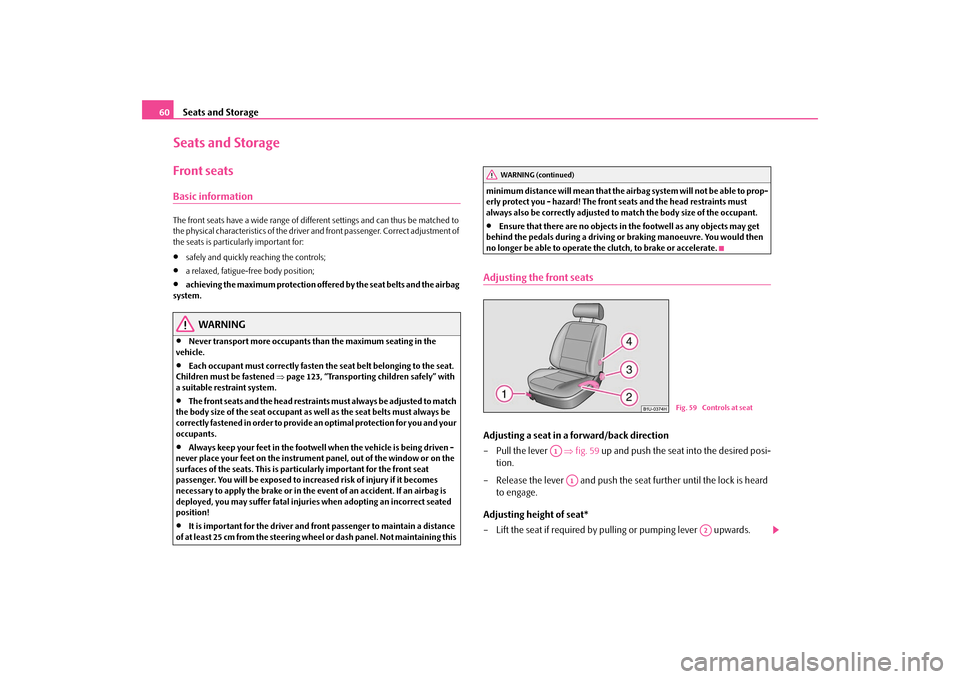
Seats and Storage
60
Seats and StorageFront seatsBasic informationThe front seats have a wide range of different settings and can thus be matched to the physical characteristics of the driver and front passenger. Correct adjustment of the seats is particularly important for:•
safely and quickly reaching the controls;
•
a relaxed, fatigue-free body position;
•
achieving the maximum protection offere
d by the seat belts and the airbag
system.
WARNING
•
Never transport more occupants than the maximum seating in the
vehicle.•
Each occupant must correctly fasten
the seat belt belonging to the seat.
Children must be fastened
⇒page 123, “Transporting children safely” with
a suitable restraint system.•
The front seats and the head restraints must always be adjusted to match
the body size of the seat occupant as well as the seat belts must always be correctly fastened in order to provide an optimal protection for you and your occupants.•
Always keep your feet in the footwel
l when the vehicle is being driven -
never place your feet on the instrument panel, out of the window or on the surfaces of the seats. This is particularly important for the front seat passenger. You will be exposed to increased risk of injury if it becomes necessary to apply the brake or in the event of an accident. If an airbag is deployed, you may suffer fatal injuries
when adopting an incorrect seated
position!•
It is important for the driver and front passenger to maintain a distance
of at least 25 cm from the steering wheel
or dash panel. Not maintaining this
minimum distance will mean that the airbag system will not be able to prop- erly protect you - hazard! The front
seats and the head restraints must
always also be correctly adjusted to match the body size of the occupant.•
Ensure that there are no objects in
the footwell as any objects may get
behind the pedals during a driving or
braking manoeuvre. You would then
no longer be able to operate the clutch, to brake or accelerate.Adjusting the front seatsAdjusting a seat in a forward/back direction – Pull the lever
⇒
fig. 59
up and push the seat into the desired posi-
tion.
– Release the lever and push the seat further until the lock is heard
to engage.
Adjusting height of seat* – Lift the seat if required by pulling or pumping lever upwards.
WARNING (continued)
Fig. 59 Controls at seat
A1
A1
A2
s2g8.b.book Page 60 Tuesday, April 7, 2009 8:53 AM
Page 62 of 224

Seats and Storage
61
Using the system
Safety
Driving Tips
General Maintenance
Breakdown assistance
Technical Data
– Lower the seat if required by pushing or pumping lever down-
wards.
Adjust the angle of the seat backrest – Relieve any pressure on the seat backrest (do not lean on it) and turn
the handwheel
⇒
page 60, fig. 59
to adjust the desired angle of the
backrest.
Adjusting lumbar support* – Turn the wheel until you have set the most comfortable curvature
of the seat upholstery in the area of your spine.
The driver's seat should be adjusted in
such a way that the pedals can be fully
pressed to the floor with slightly bent legs. The seat backrest on the driver's seat sh
ould be adjusted in such a way that the
upper point of the steering wheel can be
easily reached with slightly bent arms.
WARNING
•
Only adjust the driver seat when the ve
hicle is stationary - risk of injury!
•
Take care when adjusting the seat! Adjusting the seat without care can
lead to bruises or injuries.•
The seat backrests must not be angled too far back when driving other-
wise this will affect proper operation of the seat belts and of the airbag system - risk of injury!
Adjusting front seats electrically*Adjusting seatsAdjusting seat – Adopt the correct seated position
⇒
page 60.
– Press the switch or in the direction of the desired setting
⇒
fig. 60
.
Adjusting lumbar support – Adjust the lumbar support mechanically by turning the rotary knob
.
Switch is operated in order to move the seat up/down and forward/back, while switch is operated in order to move the seat backrest forward or back.
WARNING
•
Only adjust the driver seat when the vehicle is stationary - risk of injury!
•
Caution when adjusting the seat! You ma
y suffer injuries or bruises as a
result of adjusting the seat without paying proper attention.
A2
A3A4
Fig. 60 Side view: Controls for adjusting the seat
AA
AB
ACAAAB
s2g8.b.book Page 61 Tuesday, April 7, 2009 8:53 AM
Page 63 of 224
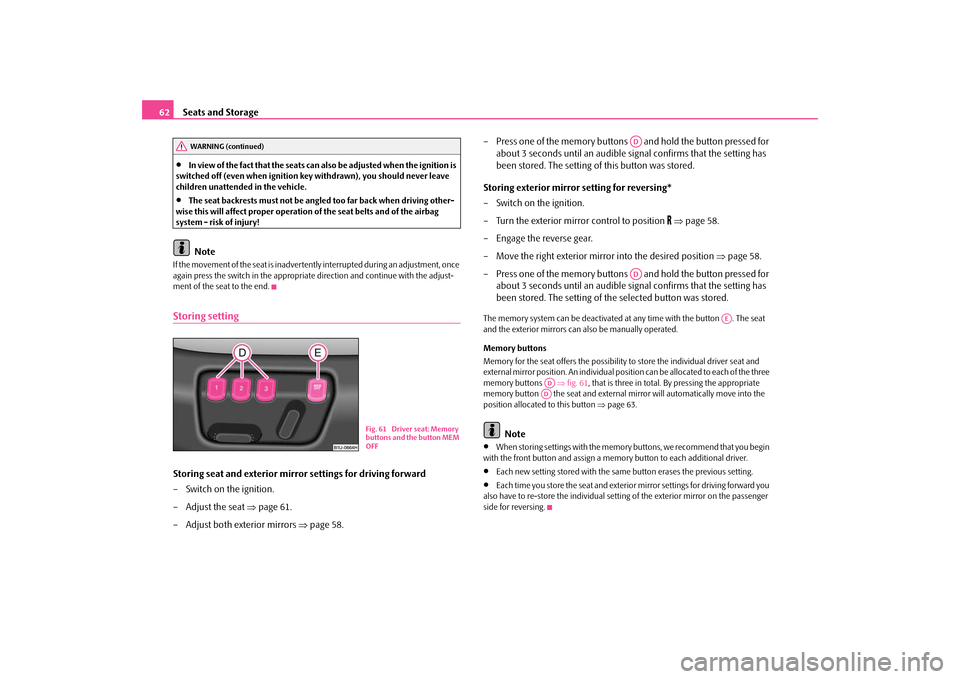
Seats and Storage
62
•
In view of the fact that the seats can
also be adjusted when the ignition is
switched off (even when ignition key withdrawn), you should never leave children unattended in the vehicle.•
The seat backrests must not be angl
ed too far back when driving other-
wise this will affect proper operation of the seat belts and of the airbag system - risk of injury!
Note
If the movement of the seat is inadverten
tly interrupted during an adjustment, once
again press the switch in the appropriate
direction and continue with the adjust-
ment of the seat to the end.Storing settingStoring seat and exterior mirror settings for driving forward – Switch on the ignition. – Adjust the seat
⇒
page 61.
– Adjust both exterior mirrors
⇒
page 58.
– Press one of the memory buttons and hold the button pressed for
about 3 seconds until an audible sign
al confirms that the setting has
been stored. The setting of this button was stored.
Storing exterior mirror setting for reversing* – Switch on the ignition. – Turn the exterior mirror control to position
⇒
page 58.
– Engage the reverse gear.– Move the right exterior mirror into the desired position
⇒
page 58.
– Press one of the memory buttons and hold the button pressed for
about 3 seconds until an audible sign
al confirms that the setting has
been stored. The setting of the selected button was stored.
The memory system can be
deactivated at any time with the button . The seat
and the exterior mirrors can also be manually operated. Memory buttons Memory for the seat offers the possibility to store the individual driver seat and external mirror position. An individual position can be allocated to each of the three memory buttons
⇒fig. 61
, that is three in total. By pressing the appropriate
memory button the seat and external mi
rror will automatica
lly move into the
position allocated to this button
⇒page 63.
Note
•
When storing settings with the memory buttons, we recommend that you begin
with the front button and assign a memory button to each additional driver.•
Each new setting stored with the same
button erases the previous setting.
•
Each time you store the seat and exterior mirror settings for driving forward you
also have to re-store the individual settin
g of the exterior mirror on the passenger
side for reversing.
WARNING (continued)
Fig. 61 Driver seat: Memory buttons and the button MEM OFF
ADAD
AE
ADAD
s2g8.b.book Page 62 Tuesday, April 7, 2009 8:53 AM
Page 64 of 224
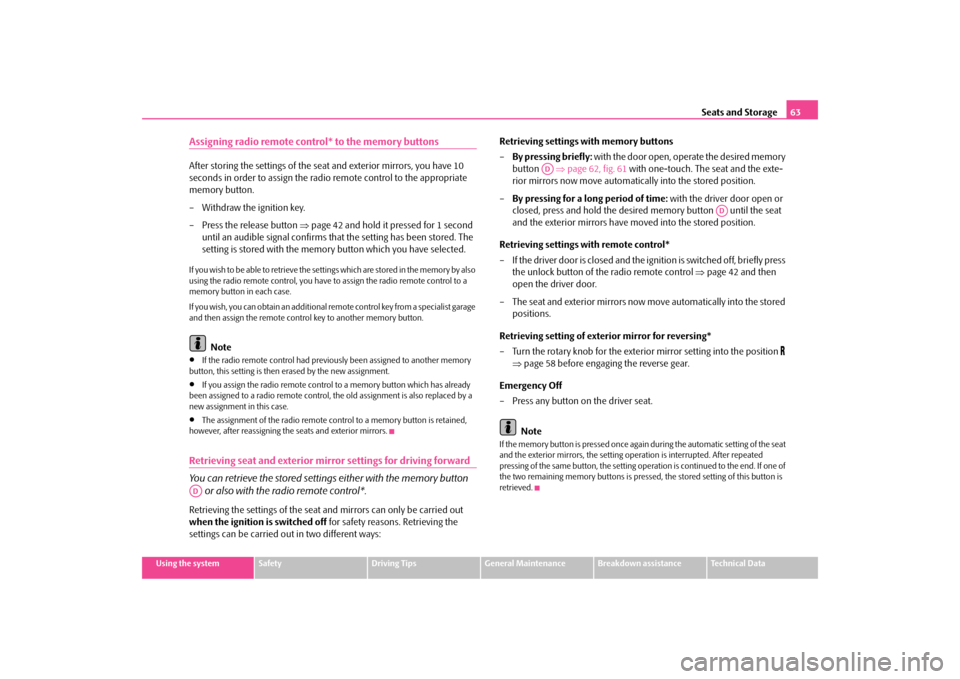
Seats and Storage
63
Using the system
Safety
Driving Tips
General Maintenance
Breakdown assistance
Technical Data
Assigning radio remote control* to the memory buttonsAfter storing the settings of the seat
and exterior mirrors, you have 10
seconds in order to assign the radio remote control to the appropriate memory button. – Withdraw the ignition key. – Press the release button
⇒
page 42 and hold it pressed for 1 second
until an audible signal confirms that the setting has been stored. The setting is stored with the memory button which you have selected.
If you wish to be able to retrieve the settings which are stored in the memory by also using the radio remote control, you have
to assign the radio remote control to a
memory button in each case. If you wish, you can obtain an additional re
mote control key from a specialist garage
and then assign the remote control key to another memory button.
Note
•
If the radio remote control had previous
ly been assigned to another memory
button, this setting is then erased by the new assignment.•
If you assign the radio remote control
to a memory button which has already
been assigned to a radio remote control,
the old assignment is also replaced by a
new assignment in this case.•
The assignment of the radio remote control to a memory button is retained,
however, after reassigning the seats and exterior mirrors.Retrieving seat and exterior mirror settings for driving forward You can retrieve the stored settings
either with the memory button
or also with the radio remote control*.
Retrieving the settings of the seat and mirrors can only be carried out when the ignition is switched off
for safety reasons. Retrieving the
settings can be carried out in two different ways:
Retrieving settings with memory buttons –
By pressing briefly:
with the door open, operate the desired memory
button
⇒
page 62, fig. 61
with one-touch. The seat and the exte-
rior mirrors now move automatically into the stored position.
–
By pressing for a long period of time:
with the driver door open or
closed, press and hold the desired memory button until the seat and the exterior mirrors have moved into the stored position.
Retrieving settings with remote control* – If the driver door is closed and the ignition is switched off, briefly press
the unlock button of the radio remote control
⇒
page 42 and then
open the driver door.
– The seat and exterior mirrors now
move automatically into the stored
positions.
Retrieving setting of exterior mirror for reversing* – Turn the rotary knob for the exterior mirror setting into the position
⇒
page 58 before engaging the reverse gear.
Emergency Off – Press any button on the driver seat.
Note
If the memory button is pressed once again
during the automatic setting of the seat
and the exterior mirrors, the setting operation is interrupted. After repeated pressing of the same button, the setting operation is continued to the end. If one of the two remaining memory buttons is pressed, the stored setting of this button is retrieved.
AD
AD
AD
s2g8.b.book Page 63 Tuesday, April 7, 2009 8:53 AM
Page 65 of 224
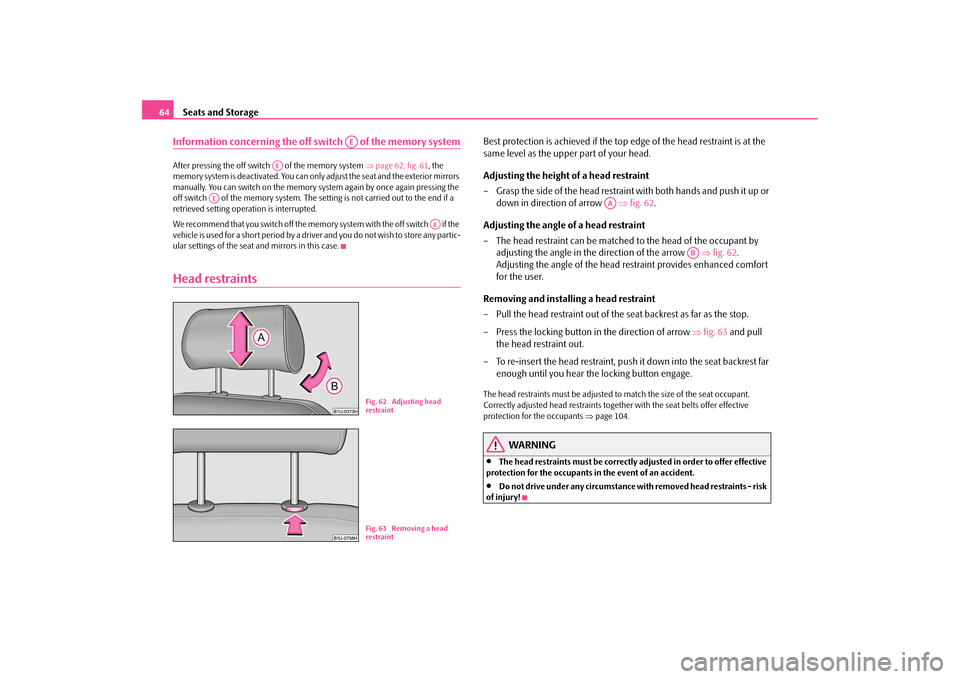
Seats and Storage
64
Information concerning the off switch of the memory systemAfter pressing the off switch of the memory system
⇒page 62, fig. 61
, the
memory system is deactivated. You can only adjust the seat and the exterior mirrors manually. You can switch on the memory sy
stem again by once
again pressing the
off switch of the memory system. The setting is not carried out to the end if a retrieved setting operation is interrupted. We recommend that you switch off the memory system with the off switch if the vehicle is used for a short period by a driver and you do not wish to store any partic-ular settings of the seat and mirrors in this case.Head restraints
Best protection is achieved if the top
edge of the head restraint is at the
same level as the upper part of your head. Adjusting the height of a head restraint – Grasp the side of the head restraint with both hands and push it up or
down in direction of arrow
⇒
fig. 62
.
Adjusting the angle of a head restraint – The head restraint can be matched
to the head of the occupant by
adjusting the angle in the direction of the arrow
⇒
fig. 62
.
Adjusting the angle of the head re
straint provides enhanced comfort
for the user.
Removing and installing a head restraint – Pull the head restraint out of the
seat backrest as far as the stop.
– Press the locking button in the direction of arrow
⇒
fig. 63
and pull
the head restraint out.
– To re-insert the head restraint, push it down into the seat backrest far
enough until you hear the locking button engage.
The head restraints must be adjusted to
match the size of the seat occupant.
Correctly adjusted head restraints togeth
er with the seat belts offer effective
protection for the occupants
⇒page 104.
WARNING
•
The head restraints must be correctly adjusted in order to offer effective
protection for the occupants in the event of an accident.•
Do not drive under any circumstance with removed head restraints - risk
of injury!
AE
AE
AE
AE
Fig. 62 Adjusting head restraintFig. 63 Removing a head restraint
AA
AB
s2g8.b.book Page 64 Tuesday, April 7, 2009 8:53 AM
Page 66 of 224
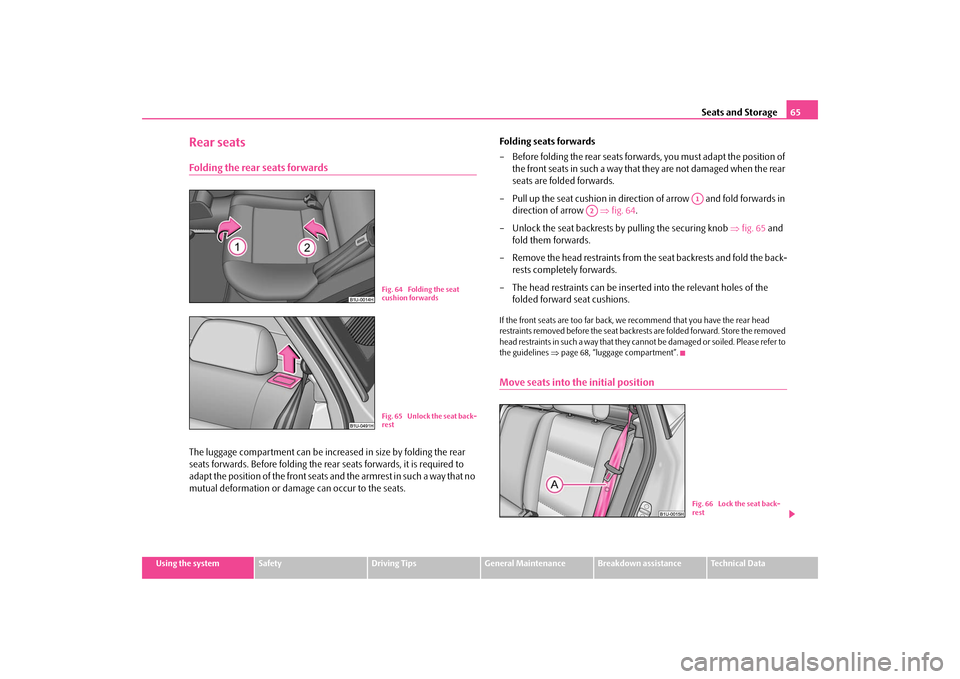
Seats and Storage
65
Using the system
Safety
Driving Tips
General Maintenance
Breakdown assistance
Technical Data
Rear seatsFolding the rear seats forwardsThe luggage compartment can be increased in size by folding the rear seats forwards. Before folding the rear seats forwards, it is required to adapt the position of the front seats and the armrest in such a way that no mutual deformation or damage can occur to the seats.
Folding seats forwards – Before folding the rear seats forwards, you must adapt the position of
the front seats in such a way that
they are not damaged when the rear
seats are folded forwards.
– Pull up the seat cushion in direction of arrow and fold forwards in
direction of arrow
⇒
fig. 64
.
– Unlock the seat backrests by
pulling the securing knob
⇒
fig. 65
and
fold them forwards.
– Remove the head restraints from the seat backrests and fold the back-
rests completely forwards.
– The head restraints can be inserted into the relevant holes of the
folded forward seat cushions.
If the front seats are too far back, we
recommend that you have the rear head
restraints removed before the seat backrests are folded forward. Store the removed head restraints in such a way that they cannot be damaged or soiled. Please refer to the guidelines
⇒page 68, “luggage compartment”.
Move seats into th
e initial position
Fig. 64 Folding the seat cushion forwardsFig. 65 Unlock the seat back-rest
A1
A2
Fig. 66 Lock the seat back-rest
s2g8.b.book Page 65 Tuesday, April 7, 2009 8:53 AM
Page 67 of 224

Seats and Storage
66
Move seats into the initial position – Install the head restraints in the slightly lifted seat backrest. – Place the rear lateral seat belt behind the edge of the side trim
panel
⇒
page 65, fig. 66
.
– Then push the seat backrest back
into the upright position until the
securing knob clicks into place - ch
eck by pulling on the seat backrest.
– Move the seat cushion into its original position.
WARNING
•
The belts and the belt locks must be in
their original position after folding
back the seat cushions and the seat backrests - they must be ready to use.•
The seat backrests must be securely interlocked in position so that no
objects in the luggage compartment ca
n slide into the passenger compart-
ment if there is sudden braking - risk of injury!•
Pay attention that the seat backrests are correctly interlocked. It is only
then that the three-point seat belt for the middle seat can reliably fulfil its function.•
Before folding the seat backrest back
into the secure position, place the
rear lateral seat belt behind the edge of the side trim panel. Take suitable measures to prevent that the seat belt
is jammed between the seat backrest
and the side trim panel and is thus damaged.
Removing the seat cushionThe luggage compartment can be increased further in size by removing the rear seat. Removing – Fold the seat cushion forwards completely. – Press the wire clamps in the direction of the arrow
⇒
fig. 67
and
remove the seat cushion from its holder.
Installing – Press the wire clamps in the direction of the arrow and place it in its
holder.
– Fold the seat cushion back into its original position.
AA
Fig. 67 Removing seat cush- ions
s2g8.b.book Page 66 Tuesday, April 7, 2009 8:53 AM
Page 68 of 224
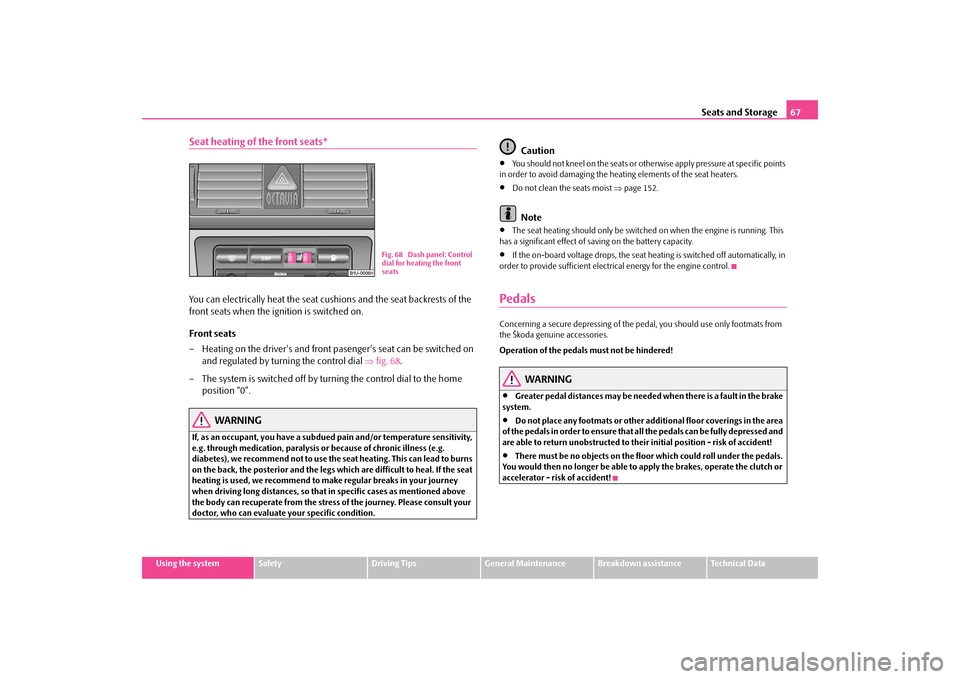
Seats and Storage
67
Using the system
Safety
Driving Tips
General Maintenance
Breakdown assistance
Technical Data
Seat heating of the front seats*You can electrically heat the seat cu
shions and the seat backrests of the
front seats when the ignition is switched on. Front seats – Heating on the driver's and front pasenger's seat can be switched on
and regulated by turning the control dial
⇒
fig. 68
.
– The system is switched off by turning the control dial to the home
position “0”.
WARNING
If, as an occupant, you have a subdued pain and/or temperature sensitivity, e.g. through medication, paralysis or because of chronic illness (e.g. diabetes), we recommend no
t to use the seat heating.
This can lead to burns
on the back, the posterior an
d the legs which are difficult to heal. If the seat
heating is used, we recommend to make regular breaks in your journey when driving long distances, so that in specific cases as mentioned above the body can recuperate from the stress of the journey. Please consult your doctor, who can evaluate your specific condition.
Caution
•
You should not kneel on the seats or othe
rwise apply pressure at specific points
in order to avoid damaging the heating elements of the seat heaters.•
Do not clean the seats moist
⇒page 152.
Note
•
The seat heating should only be switched
on when the engine is running. This
has a significant effect of sa
ving on the battery capacity.
•
If the on-board voltage drops, the seat heating is switched off automatically, in
order to provide sufficient electrical energy for the engine control.PedalsConcerning a secure depressing of the pe
dal, you should use only footmats from
the Škoda genuine accessories. Operation of the pedals must not be hindered!
WARNING
•
Greater pedal distances may be needed when there is a fault in the brake
system.•
Do not place any footmats or other additional floor coverings in the area
of the pedals in order to ensure that
all the pedals can be
fully depressed and
are able to return unobstructed to their initial position - risk of accident!•
There must be no objects on the floor which could roll under the pedals.
You would then no longer be able to
apply the brakes, oper
ate the clutch or
accelerator - risk of accident!
Fig. 68 Dash panel: Control dial for heating the front seats
s2g8.b.book Page 67 Tuesday, April 7, 2009 8:53 AM
Page 69 of 224
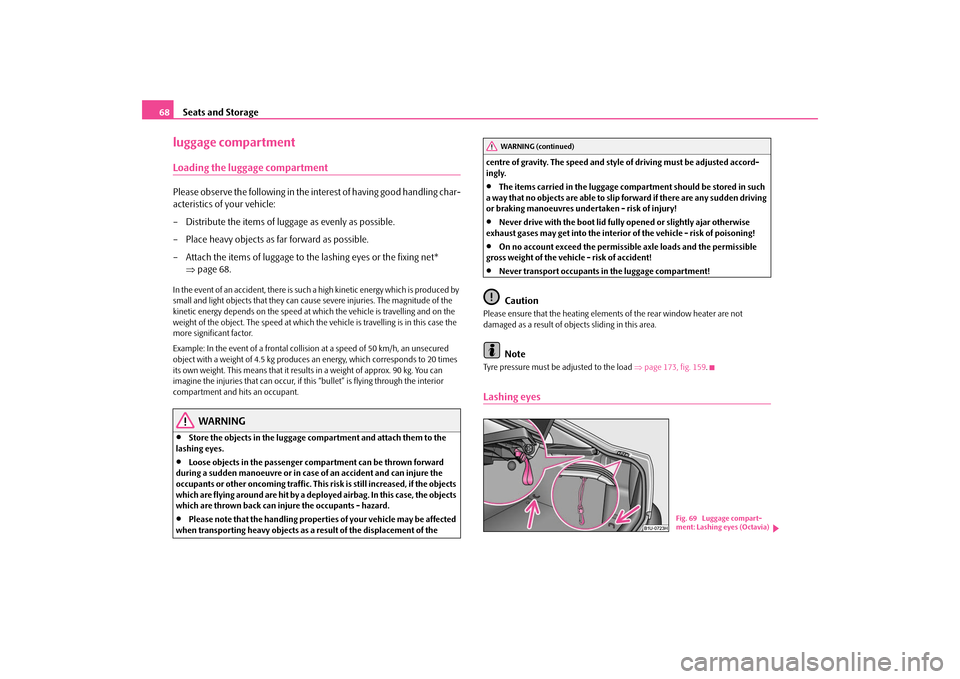
Seats and Storage
68
luggage compartmentLoading the luggage compartmentPlease observe the following in the inte
rest of having good handling char-
acteristics of your vehicle: – Distribute the items of luggage as evenly as possible.– Place heavy objects as far forward as possible. – Attach the items of luggage to the lashing eyes or the fixing net*
⇒
page 68.
In the event of an accident, there is such a
high kinetic energy wh
ich is produced by
small and light objects that they can caus
e severe injuries. The magnitude of the
kinetic energy depends on the speed at wh
ich the vehicle is travelling and on the
weight of the object. The speed at which the
vehicle is travelling is in this case the
more significant factor. Example: In the event of a frontal collision at a speed of 50 km/h, an unsecured object with a weight of 4.5 kg produces
an energy, which corresponds to 20 times
its own weight. This means that it results in a weight of approx. 90 kg. You can imagine the injuries that can occur, if th
is “bullet” is flying
through the interior
compartment and hits an occupant.
WARNING
•
Store the objects in the luggage comp
artment and attach them to the
lashing eyes.•
Loose objects in the passenger compartment can be thrown forward
during a sudden manoeuvre or in case of an accident and can injure the occupants or other oncoming traffic. This risk is still increased, if the objects which are flying around are hit by a depl
oyed airbag. In this case, the objects
which are thrown back can injure the occupants - hazard.•
Please note that the handling properti
es of your vehicle may be affected
when transporting heavy objects as a result of the displacement of the
centre of gravity. The speed and style
of driving must be adjusted accord-
ingly.•
The items carried in the luggage compar
tment should be stored in such
a way that no objects are able to slip forward if there are any sudden driving or braking manoeuvres undertaken - risk of injury!•
Never drive with the boot lid fully opened or slightly ajar otherwise
exhaust gases may get into the interior
of the vehicle - risk of poisoning!
•
On no account exceed the permissi
ble axle loads and the permissible
gross weight of the vehicle - risk of accident!•
Never transport occupants
in the luggage compartment!
Caution
Please ensure that the heating elements of the rear window heater are not damaged as a result of objects sliding in this area.
Note
Tyre pressure must be adjusted to the load
⇒page 173, fig. 159
.
Lashing eyes
WARNING (continued)
Fig. 69 Luggage compart- ment: Lashing eyes (Octavia)
s2g8.b.book Page 68 Tuesday, April 7, 2009 8:53 AM
Page 70 of 224
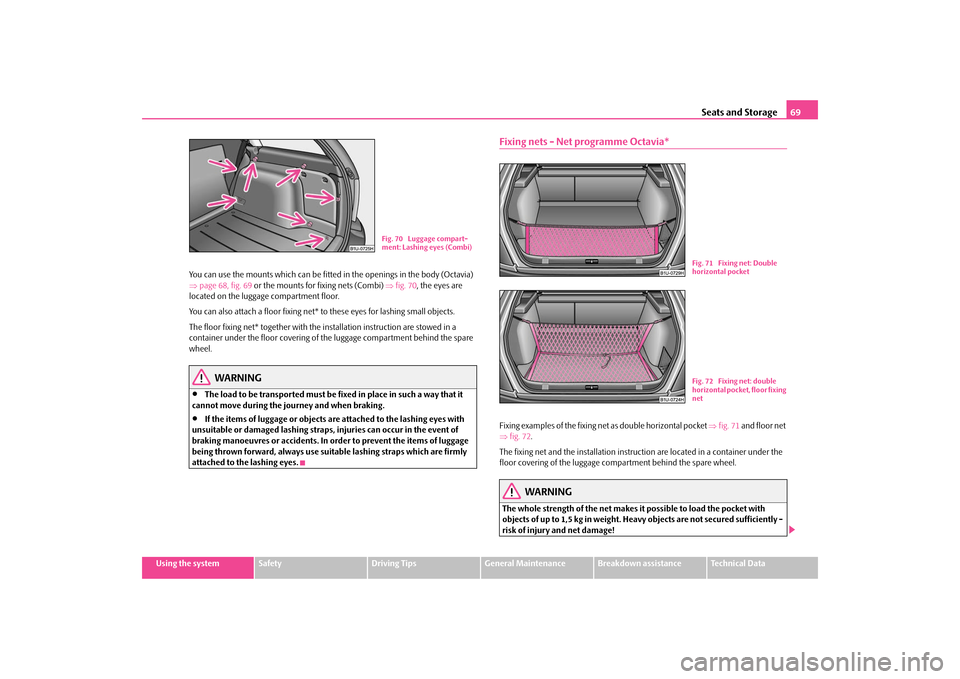
Seats and Storage
69
Using the system
Safety
Driving Tips
General Maintenance
Breakdown assistance
Technical Data
You can use the mounts which can be fitted
in the openings in the body (Octavia)
⇒ page 68, fig. 69
or the mounts for fixing nets (Combi)
⇒fig. 70
, the eyes are
located on the luggage compartment floor. You can also attach a floor fixing net*
to these eyes for lashing small objects.
The floor fixing net* together with the
installation instruction are stowed in a
container under the floor covering of the luggage compartment behind the spare wheel.
WARNING
•
The load to be transported must be fi
xed in place in such a way that it
cannot move during the journey and when braking.•
If the items of luggage or objects are
attached to the lashing eyes with
unsuitable or damaged lashing straps,
injuries can occur in the event of
braking manoeuvres or ac
cidents. In order to prevent the items of luggage
being thrown forward, always use suitable lashing straps which are firmly attached to the lashing eyes.
Fixing nets - Net programme Octavia*Fixing examples of the fixing ne
t as double horizontal pocket
⇒fig. 71
and floor net
⇒ fig. 72
.
The fixing net and the installation instru
ction are located in
a container under the
floor covering of the luggage compartment behind the spare wheel.
WARNING
The whole strength of the net makes it possible to load the pocket with objects of up to 1,5 kg in weight. Heavy objects are not secured sufficiently - risk of injury and net damage!
Fig. 70 Luggage compart- ment: Lashing eyes (Combi)
Fig. 71 Fixing net: Double horizontal pocketFig. 72 Fixing net: double horizontal pocket, floor fixing net
s2g8.b.book Page 69 Tuesday, April 7, 2009 8:53 AM